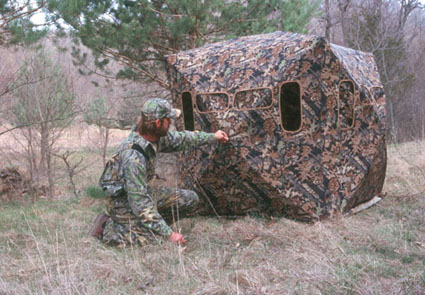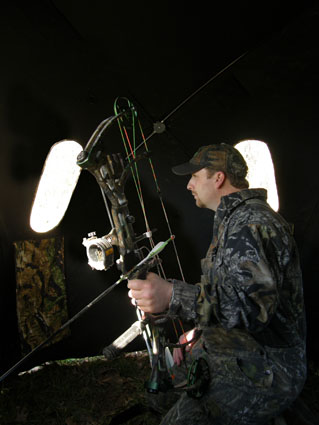 Say whitetail with a bow, and most folks envision a camo-clad archer nestled within the leafy arms of a majestic oak, his feet and behind securely planted on a 24-inch square of corrugated aircraft aluminum and a padded swivel seat, respectively. And it’s only natural, for everyone knows that in order to defeat a whitetail buck's first and second lines of defense — his nose and his eyes — going elevated is indeed the way to go. Or is it?
Say whitetail with a bow, and most folks envision a camo-clad archer nestled within the leafy arms of a majestic oak, his feet and behind securely planted on a 24-inch square of corrugated aircraft aluminum and a padded swivel seat, respectively. And it’s only natural, for everyone knows that in order to defeat a whitetail buck's first and second lines of defense — his nose and his eyes — going elevated is indeed the way to go. Or is it?
During the last decade, many of the nation’s top whitetail hunters, as well as a growing contingent of turkey hunters, have been leaving their treestands behind and opting for a quiet, comfortable seat at ground level. On the ground?! Yes, and as difficult as it is for some to believe, many of today’s most avid hunters have come full circle; that is, they’ve gone through their treestand phase, and have come to recognize the potential of a well-constructed and expertly camouflaged ground blind.
It’s a ground blind revolution, or evolution perhaps is a better term. Regardless of what you’re prone to call it, ground blinds continue to gain in popularity. What’s more, the folks who manufacture ground blinds have noticed this trend, and are going to great lengths to give today’s ground-bound hunter exactly what he or she is looking for in terms of concealment, scent control, mobility, camouflage options, room, comfort, visibility and a long list of other variables. Let's take a closer look.
Portability — This element brings to the forefront a very noteworthy point in the ground blind vs. elevated blind debate — mobility. A shooting house, as one might find in Texas, isn’t what you would call portable; however, a climbing treestand in the hands of an experienced user can be easily relocated, often within minutes. Likewise, the natural blind built of oak limbs  and blended with cedar boughs is going to have to have been constructed in a well-scouted location. But on the other hand, a modern pop-up style blind can easily be collapsed, and both it and you repositioned essentially in little more time than it requires to get to where you’re going. Here, strap-on treestands and ground-based blinds might prove equals. However, I’d give the nod to the stick-and-fabric ground blind in terms of mobility.
and blended with cedar boughs is going to have to have been constructed in a well-scouted location. But on the other hand, a modern pop-up style blind can easily be collapsed, and both it and you repositioned essentially in little more time than it requires to get to where you’re going. Here, strap-on treestands and ground-based blinds might prove equals. However, I’d give the nod to the stick-and-fabric ground blind in terms of mobility.
Scent control — Without question, raising yourself 25 feet off the ground also raises your scent a like distance, or at least that’s the way it’s supposed to work. Wind does incredible things, as many an archer has discovered, and simply pulling yourself up into a tree doesn’t mean you don’t have to mind your odor. Here, height above ground helps, but it doesn’t eliminate.
This all said, it would seem logical a ground-based blind would mean more scent on ground level. Correct? Perhaps, but not necessarily so. Several of today’s makers of modern pop-up style blinds have versions of their product complete with a scent-controlling material incorporated into the inner walls of the blind itself. Combined with proper personal hygiene — scent-eliminating soaps, shampoos, deodorants and laundry practices — and any of the effective scent-containing clothing, these high-tech ground blinds are capable of trapping most of your scent before it has a chance to escape. Ozonics units, and other devices such as ZeroTrace from Wildgame Innovations, which relies on PureION technology, can also help hide or eliminate a hunter's odor. Certainly, it’s still advisable to watch the wind, but human scent, it seems, is no longer the problem it once was for the ground blind user.
Comfort — Comfort, be it warm clothing or a cushy seat, keeps hunters in the field longer, and the longer you stay in the field, the better your chances of filling your tag. And there’s little denying a 6-foot by 6-foot by 7-foot high, wind-blocking ground blind ranks much higher on the comfort scale than does an exposed 24-inch square metal platform perched 20 feet up a white oak.
 Concealment — True, there are few places better to visually hide from a whitetail than in an elevated stand; however, ground blinds — that is, properly constructed and positioned blinds — need not be lacking in the concealment category. In fact, a properly camouflaged ground blind probably offers much more in the way of invisibility than does a 24-inch square piece of steel strapped to the side of a cottonwood tree, especially if it’s November in Iowa and there’s not a leaf to be found except on the ground.
Concealment — True, there are few places better to visually hide from a whitetail than in an elevated stand; however, ground blinds — that is, properly constructed and positioned blinds — need not be lacking in the concealment category. In fact, a properly camouflaged ground blind probably offers much more in the way of invisibility than does a 24-inch square piece of steel strapped to the side of a cottonwood tree, especially if it’s November in Iowa and there’s not a leaf to be found except on the ground.
Too, there’s the fact that ground blinds typically provide a higher margin for hunter error in terms of movement. That is, a well-built natural blind or commercial hide can allow you much more freedom of movement throughout the hunting period than might an exposed, perhaps precarious, and traditionally much smaller elevated blind.
If you don't have confidence Camo Pattern X is going to make your blind vanish into the natural setting, it's best to brush up the blind to eliminate the hard edges and straight lines. Cedar boughs, leafy oak branches, tumbleweeds, cattails, wild grapevines and corn stalks work well. Anything to help break up and disguise the boxy nature of the hide. However, be careful not to overdo it. Your goal here is break up the human or unnatural construction elements, not create an out-of-place ball of suspicion.

Visibility — In most situations, you simply cannot see as well nor as far from ground level as you can from a perch 25 feet above the earth. It’s just that simple. However, it is possible to minimize this variable by taking pains to position your ground blind so as to maximize what you can see.
The latest pop-up blinds such as the Primos SurroundView feature see-through walls that provide tremendous visibility in almost all directions without allowing deer to see you inside. Such blinds eliminate the need to constantly shift back and forth in your chair to peek out small windows.







